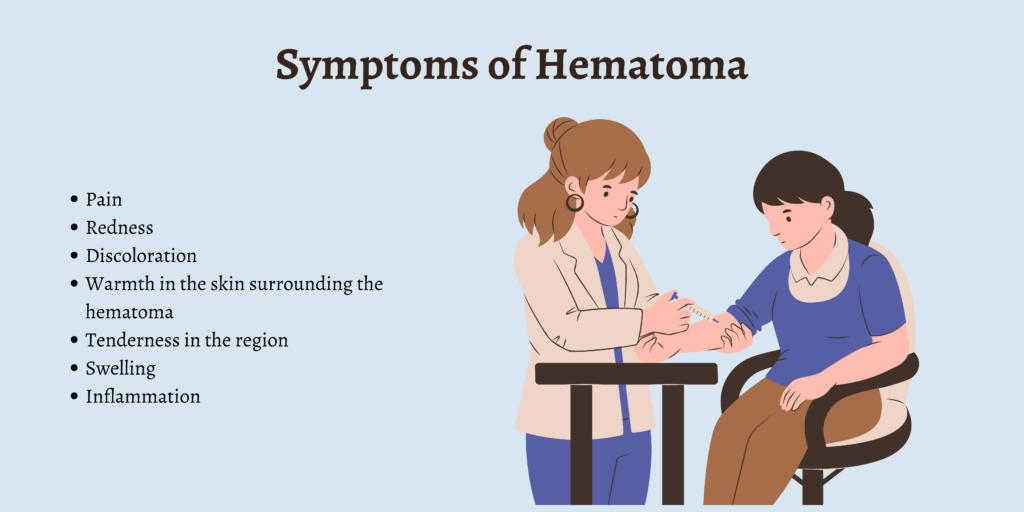First Aid for Hematoma: 4 Effective Management Tips
As per reports, epidural hematoma takes place in about 1% to 2% of all cases of head trauma and in about 10% of people in a traumatic coma. Despite this statistic, I believe that not many know about hematoma, which is what I’m about to discuss today.
A hematoma can be defined as an abnormal pooling of blood under a person’s skin caused by a ruptured or broken blood vessel. This occurs when the wall of a blood vessel wall, capillary, vein, or artery gets damaged, causing blood to leak into the tissues where it doesn’t belong.
Hematomas can be tiny, where they are not bigger than just a spot of blood, or they can be big and lead to prominent swelling. While a minor injury such as a mild bruise can cause the skin to change color, a hematoma is usually more serious.
Based on their cause and the body part that is affected, hematomas can be life-threatening.
For instance, when a head injury leads to clotted blood, it should be given medical attention immediately, and the same applies to a rapidly swelling hematoma as it causes the circulation to a limb to be cut off.
Did you know that hematomas can occur anywhere in the human body? Regardless of where they are located, they remain to be a collection of clotted blood located outside of a blood vessel.
In this article, we will be discussing the types and symptoms of hematoma, their causes, how to diagnose and prevent them, and how to treat them.
Types of Hematomas
The type of hematoma is linked to the body part where it forms, with the location often helping to determine how dangerous it can be. Some of the different types of hematomas are as follows:
- Spinal epidural hematoma: Spinal epidural hematoma is the hematoma that occurs between the lining of the spinal cord and the vertebrae.
- Intracranial epidural hematoma: Intracranial epidural hematoma takes place between the lining on the outside of the brain and the skull plate.
- Subdural hematoma: Subdural hematoma refers to the hematoma between the surface of the brain and the skull, and it usually stems from a head injury.
- Subungual hematoma: Subungual hematoma appears under the nail and can occur through minor injuries, including accidentally hitting a hammer on your finger.
- Septal hematoma: Septal hematoma usually results from a broken nose and can lead to nasal issues if proper treatment isn’t provided.
- Retroperitoneal hematoma: Retroperitoneal hematoma takes place inside the abdominal cavity and not inside any organs in the human body.
- Hepatic hematoma: Hepatic hematoma happens in the liver.
- Splenic hematoma: When a hematoma occurs in the spleen, it’s known as splenic hematoma. This is commonly seen in blunt-force abdominal trauma.
- Intramuscular hematoma: When a hematoma appears in the muscle tissue, it’s called intramuscular hematoma. It’s usually seen in the lower arms and lower legs.
Symptoms of Hematoma

When a hematoma is more superficial, the symptoms of it are:
- Pain
- Redness
- Discoloration
- Warmth in the skin surrounding the hematoma
- Tenderness in the region
- Swelling
- Inflammation
When a hematoma is in the skull, it can be quite serious. Even when you get it checked by a doctor, you must be cautious of any new symptoms that could crop up, such as:
- Seizures
- Vision changes
- Hearing loss
- Loss of consciousness
- A headache that is severe and keeps getting worse
- Confusion
- Loss of movement on one side of the body
- Changes in personality, including mood swings
- Frequent falls or difficulty in walking
Causes of Hematoma
Trauma and injuries are often the cause of hematoma. Whenever damage is caused to the walls of the blood vessels, it can lead to blood leakage. As this blood oozes out of the blood vessels, it pools and creates a hematoma.
Hematomas aren’t always caused by severe injuries. At times, even a simple injury, such as stubbing one’s toe, can lead to a hematoma under the toenails. Serious hematomas can be caused due to major injuries such as aneurysms, falling from a height, and vehicle crashes.
Surgical procedures that damage the tissues and blood vessels can also cause hematomas, and this includes cosmetic, dental, and medical operations. The risk of a hematoma increases when blood thinners are involved.
There are certain medicines as well that could increase the chances of developing hematoma, such as warfarin, aspirin, and dipyridamole. Often, unidentifiable causes, too, are associated with hematomas.
How is Hematoma Diagnosed?
When you go to a doctor, they will ask for your medical history and then conduct a physical examination as the first two steps of diagnosing a hematoma. There aren’t any specific blood tests involved in the diagnosis of hematomas. However, your doctor could recommend the following tests:
- Complete blood count (CBC)
- Chemistry and metabolic panel
- Coagulation panel
- Liver tests
Listed below are the imaging tests that are often involved in diagnosing a hematoma:
- CT scan: It helps in diagnosing subdural hematoma
- Abdominal CT scan: It helps in diagnosing the presence of a hematoma in the abdominal cavity.
- MRI scan: It can aid in diagnosing an epidural hematoma and is more reliable than a CT scan for this purpose
Treatment for Hematoma
In certain cases, hematoma doesn’t require any treatment as the patient’s body reabsorbs the blood from the hematoma with time. Here are a few things to know about the treatment of hematomas:
- If there is a hematoma under the nail, skin, or any other soft tissue, make sure to rest the injured region. Wrap an ice pack in a towel and apply it to the affected area to deal with any swelling or pain.
- Keep the area supported or wrapped so that the blood vessel doesn’t reopen as it heals. Ask your doctor how to do this properly, if required
- In case the injury is painful to the patient, their doctor could recommend them over the counter or prescription pain relievers. They could ask them to avoid certain pain relievers that could worsen the hematoma and cause blood thinning, such as aspirin.
- Surgical drainage could be needed in certain cases of hematoma. This might be required if the blood puts pressure on the brain, spinal cord, or other organs. If the hematoma poses a risk of infection, your doctor might drain it.
Surgical procedures often become necessary even if the hematoma is located within the person’s skull. For instance, a study was conducted in 2015 among people with subdural hematoma. The majority of these people were given conservative treatment, and just 6.5% of them needed surgical treatment later on.
There are also certain rare cases wherein the hematoma keeps on growing while the damaged blood vessel keeps letting out more blood. As a result of this, the combination of new and old blood might have to be removed completely.
How to Prevent a Hematoma
The method to prevent a hematoma involves keeping yourself safe while participating in activities that could lead to hematomas, which includes playing sports.
At times, the prevention techniques can involve something as simple as arranging your home in a manner such that you don’t trip over or even putting on a helmet while riding a bike.
You should contact your healthcare provider if you take any medicines or have a medical condition that affects blood clotting. Discuss with them the steps to take if you get hurt and how your condition affects your risk of developing a hematoma or other bleeding issues.
FAQs
Does a hematoma go away?
Yes, a hematoma does go away as the blood in the hematoma gets absorbed back into the person’s body.
How long does a hematoma last?
Depending on what caused the hematoma, it can last for anywhere between one to four weeks.
How serious is a hematoma?
A hematoma can be quite life-threatening as it can cause serious harm, and one’s blood pressure can drop if it gets too large.
Are hematomas painful?
A hematoma under the skin or nail can be painful, and one must visit a doctor if it gets too painful.
Should I massage a hematoma?
No, it’s advised not to massage a hematoma.
Can a hematoma look like a tumor?
hematoma can often be mistaken for a tumor if it gets large enough.
Is heat good for hematoma?
Yes, a heat compress can be used on a hematoma after the first 48 hours.
Conclusion
Although a hematoma can appear frightening, proper treatment can ensure that they don’t cause any permanent damage. Based on the body part they affect and what caused them, hematomas can either be harmless or life-threatening.
When someone suffers from a minor hematoma, such as under the nail or in the ear, they can treat it at home. The involvement of a healthcare professional is required when a person has been in an accident, experienced a head injury, or developed a hematoma that displays signs of infection.
When proper treatment and a quick diagnosis are involved, hematomas can be dealt with without any complications.





